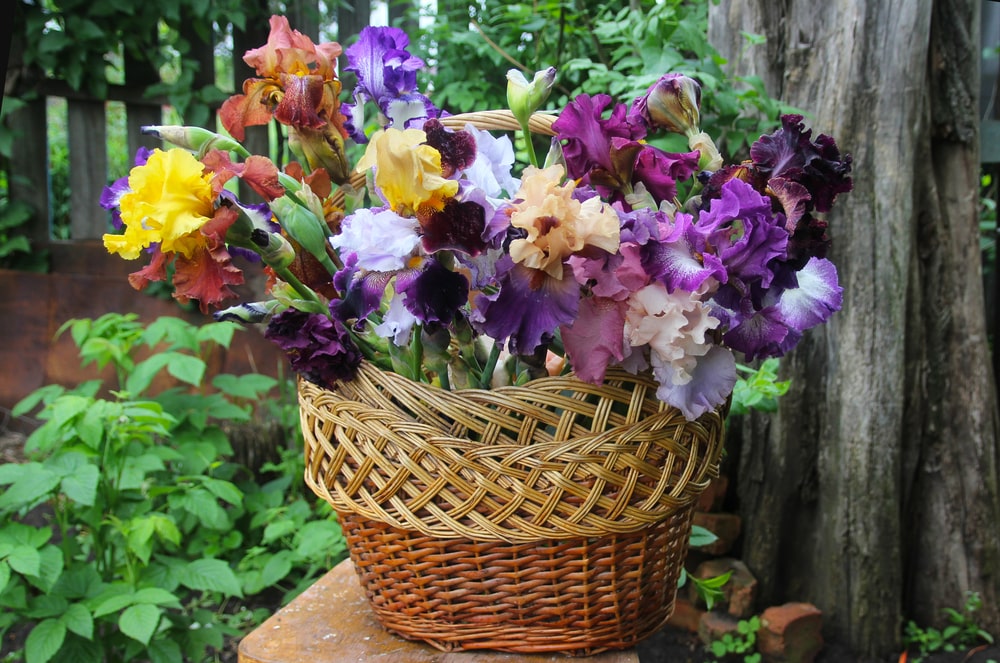I love the iris family of flowers! And right now is the ideal time to plant this hardy, beautiful gift from Mother Nature.
Let’s learn some interesting facts about irises, and talk about how you can plant them in your garden to create an amazing rainbow of colors in the spring.
Interesting Facts About Irises
- In Greek mythology, Iris was a messenger from the gods who traveled to earth on a rainbow. Wherever she stepped, flowers sprang up. The word “Iris” means ‘rainbow’—appropriate since bearded iris comes in a vast array of colors from pure white to purple/black—and nearly every color in between.
- The three upright petals on an iris flower stand for faith, wisdom, and valor.
- An extract from the iris, called Orris Root, is used as an additive to perfumes and is the most widely used fixative for potpourri. Often used in cosmetic powders, Orris root is also an ingredient in some brands of gin.
- Irises are hardy perennials and grow from either rhizomes or bulbs. Most irises are native to the Northern Hemisphere from Europe to Asia, though there are a few species native to eastern North America.
- Bearded irises are in the same family (Iridaceae) as gladiolus and crocus.
- Bearded iris flowers consist of three upright petals called ‘standards’ and three drooping sepals called “falls.” Bearded iris is called that because of the fuzzy ‘beard’ that runs down each sepal. The beards are often bright gold or melon orange—offering a vivid contrast to the color of the flower itself.
- The Iris is February’s “birth” flower.
- A stylized iris, the Fleur de Lis is the symbol of New Orleans.
Bearded Iris – Perhaps the Most Famous Member of the Iris Family
Bearded irises are sturdy easy-to-grow plants needing only a sunny spot and well-drained soil. The rhizomes are available in late summer/early fall. Bearded irises have bigger showier flowers than other varieties. Depending on the variety, they bloom anytime from mid-May to mid-late June and some varieties, called remontants, will bloom again at summer’s end.
How to Grow Your Own Bearded Iris
To plant bearded irises, choose a sunny spot with well-drained soil. The rhizomes come with roots and a fan of leaves at the top. Plant the stem with the root side down, but the top of the stem is exposed to light and air. Top-dress lightly with Bulb-tone. Feed again in the spring when they start to come up.
Always plant bearded iris at least 12” apart as the rhizomes make new plants every year. If they’re too close together, they will not bloom as well.
Regular irises don’t need much attention after they bloom except for water in periods of extreme drought. Keep their beds weeded and if you mulch, DO NOT mulch over the top of the rhizomes. Be sure to keep dead leaves or debris out of the iris bed as they can encourage rot. Irises do not like in-ground sprinklers.
Re-blooming Iris
There are bearded irises that bloom in the spring and again at summer’s end. If you have re-blooming varieties, then feed them after they bloom the first time and keep them watered over the summer—remembering to let them dry out partly.
Other Iris
Dutch irises are smaller than bearded irises so take up less space and are good for adding color where space is more limited. They are about 24” tall and usually bloom in May.
Miniature iris bulbs are also available in the fall. They bloom about the same time crocus do and are daintier—about six to eight inches tall. Both Dutch and miniature irises come in around the first week of September and can be planted in mid-October. Like bearded irises, they prefer full sun and well-draining soil. Plant the bulbs about 4 inches deep.
Grow a Rainbow for An Amazing Colorful Spring Yard
Irises are tough, durable, and perennial bloomers, and they are not generally bothered by pests—very important here in “Deer Country.”
Bearded iris rhizomes have just arrived at the store, so come in and pick out your own rainbow!


Thank you for the information on irises. I was planning on adding them to a small dry creek feature I want to build but it sounds like there may not be enough sunshine…the area is on a slope and fairly shady. Do you know of any other flowering plants of similar stature and height that I could use instead? Thanks so much..
Janna
Hi Janna–yes, Iris are sunlovers but there are a number of other shade tolerant perennials–astilbe, hosta, Solomon’s Seal. Come in and let us show you some options!